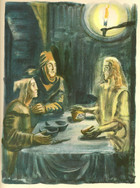Albert Decaris
(1901-1988)
Albert Decaris is one artist whose work attracts collectors with interests other than the fine arts. Over a fifty year period, beginning in 1935, the French Printmaker designed and engraved over 600 postage stamps for France, its former colonies, and other Francophone states, depicting everything from the French national symbol of the Cockerel and the Ocean Liner Normandie to aerial views of Paris and portraits of Benjamin Franklin and St. Teresa of Avila.
Decaris was not only skilled in the miniature engraving of stamps. He was equally comfortable creating prints for Stations of the Cross series large enough to hang on church walls. In fact, in a career spanning over six decades, Decaris produced as many as 6,000 engravings in all sizes and formats. Small wonder he is widely regarded as France’s Master Engraver of the 20th century.
Engraving is the form of print-making closest to sculpture, requiring artists to dig their lines directly into metal plates, most often copper, using hardened steel tools with varying cutting edges called burins. Decaris noted in later life that it was purely by chance that he learned engraving, when he left his native Normandy at the age of 15 to enroll in the L’Ecole Estienne in Paris, a school specializing in industrial graphics.
Three years later, Decaris was so skilled in his newly acquired art form he became the youngest student at the Paris Ecole des Beaux-Arts ever to win the Prix de Rome and an opportunity to study in Italy at the Villa Medici. The engraver from the north of France fell in love with the Mediterranean World and would return time and again in his works (and on foot) to the sunlit landscapes of Italy, Spain, and Greece and to the themes of Greco-Roman mythology.
Known as the “Monk Engraver” for his dedication to his craft, Decaris spent 15 to 16 hour work days, laboring with parallel lines, cross hatching, dots, and random markings to create images of classical clarity with clear touches of Art Deco styling. He excelled at architectural studies--have a look at in his engraving, Madonna of Siena--and was a much sought after book illustrator. His prints appear in editions of Homer, Euripides, Shakespeare, Cervantes, Pascal, Stendhal, and other literary greats, as well as in a life of Kings David and Solomon and a popular history of Jesus Christ.
There was little room for modernist abstraction in Decaris’ well-ordered visual world, and his style remained largely unchanged throughout his long career. He was a member of France’s prestigious Academie des Beaux-Arts and elected its President in 1960. The Master Engraver did have a whimsical side and was commemorated in his homeland by a 2001 stamp issue, incorporating a delightful Decaris image of the Arch of Triumph courting the Eiffel Tower.
Decaris’s first prize-winning engraving as a teenager was on the biblical theme of Eve Before the Fall. He engraved two large-scale Stations of the Cross cycles for a church in Besancon in 1951 and one in Paris in 1963. The prints of Station III, Station IV, and Station XII in the Sacred Art Pilgrim Collection appear to be from the latter series. You can see the hand of a skilled technician in the sheen of the Roman armor and in the bulging belly and taut torso of the crucified thieves. A fourth engraving shows Jesus coiffed and garbed like a hero of Greek myth, posed against a detailed landscape of terraced Mediterranean dwellings.
The engraved portrait of Christ echoes the frontispiece of Jesus en son temps, a best-selling study of Jesus and his times by French Roman Catholic Writer Daniel-Rops, reprinted in 1953 with 45 color lithographs by Decaris. This visually sumptuous image suite on the Gospel narratives with its boldly colored landscapes and sketchily drawn, highly decorative crowd scenes is a striking departure from the artist’s usual architectonic, black and white engravings. It makes you wonder just what the Master Engraver might have achieved had he directed his formidable energies to watercolor, gouache or oil painting.

Albert Decaris Commemorative Stamp
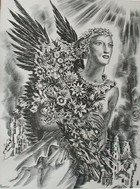
Angel of Peace
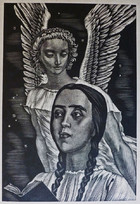
Annunciation
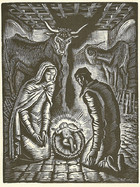
Nativity

The Madonna of Siena
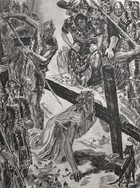
Station III
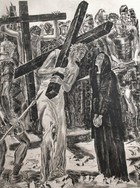
Station IV
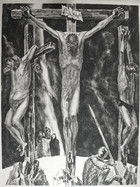
Station XII
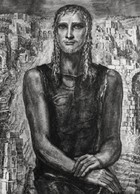
Jesus
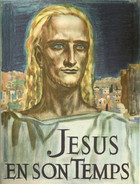
Frontispiece

The Baptism of Christ
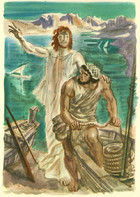
The Calling of Simon Peter
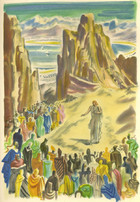
The Sermon of the Mount
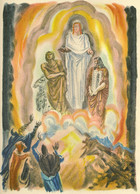
The Transfiguration
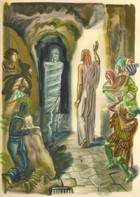
The Raising of Lazarus
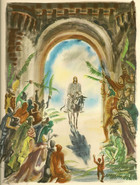
The Triumphal Entry
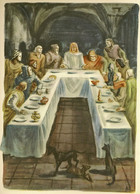
The Last Supper
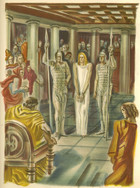
Christ Before Pilate
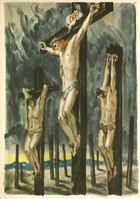
The Crucifixion
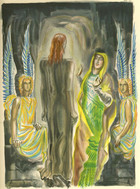
Jesus Appears to Mary Magdalene
